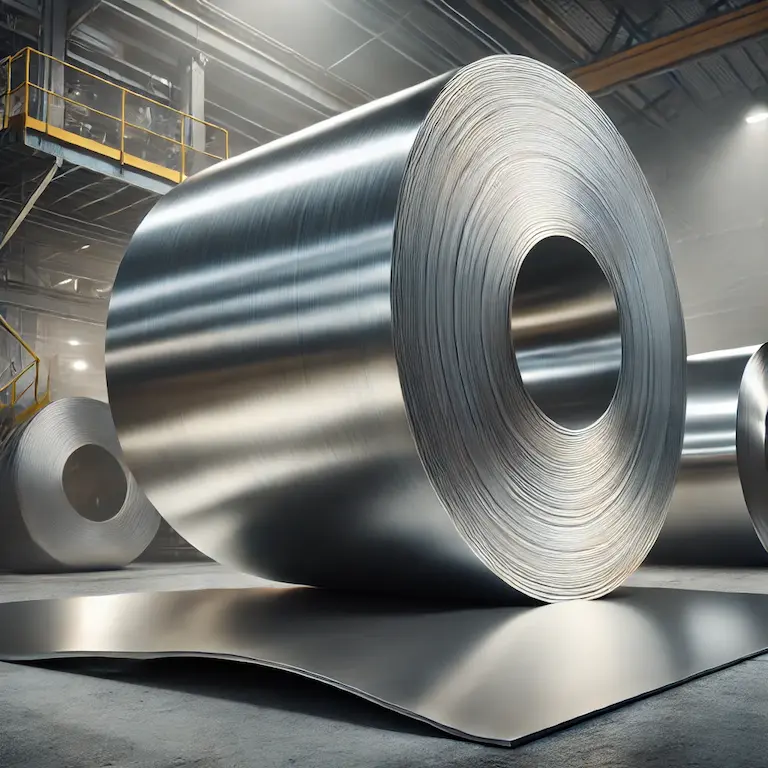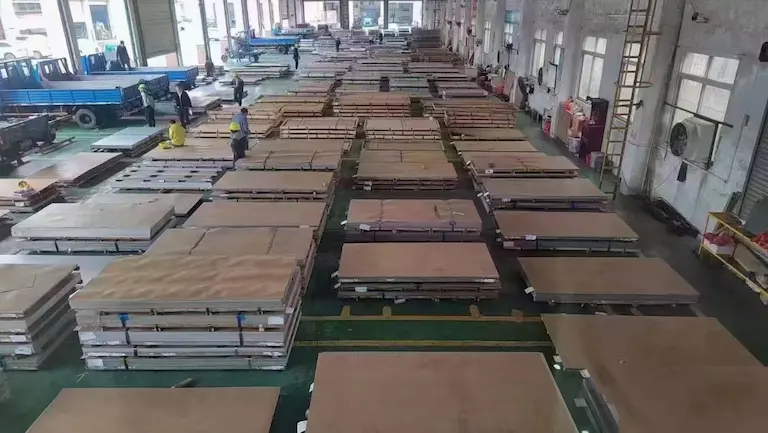ASTM A240 Type 304: Properties, Pricing, and Applications

Ewan Liao

Stainless steel ASTM A240 type 304 is by far the most popular in the commercial market, while the high-end market is favorite for stainless steel type 321. In its annealed state, it is essentially non-magnetic, but becomes magnetic when subject to cold work.
In welding, it is useful to use stainless steel type 304L rather than carbon stainless steel to prevent chromium carbides from forming during cooling in the heat affected region of the welding process. The alloys used in this formulation offer an excellent balance of resistance to corrosion and manufacturing.
There are many usable stainless steel grades, such as Grade 304, but Grade 304 is the most common grade. Grade 304 is an austenitic chromium alloy also known as an “18/8” stainless steel, based on 18% and 8% of the chromium and nickel content of the steel.
Material Testing After You Place An Stainless Steel Foil Order
Hardness Testing
Ingredient detection
Tensile Strength Test
Table of Contents
What is ASTM A240 Type 304?
ASTM A240 Type 304 is a specification under the ASTM A240 standard, which defines requirements for chromium and chromium-nickel stainless steel plate, sheet, and strip used in pressure vessels and general applications. Type 304, commonly referred to as 18/8 stainless steel, is the most widely used stainless steel grade due to its excellent corrosion resistance, ease of fabrication, and versatility.
Key Features of ASTM A240 Type 304
In contrast, the 304L version is not suitable for welding due to its lack of resistance to carbide precipitation and corrosion, which manifests itself as a localized corrosion or corrosion on only one section of the weld. The ASTM A240 Stainless Steel 304 Coil Thickness is variable and extends to a maximum of 200mm in diameter and 1,000 feet in length. It is also compatible with a variety of widths, depending on the requirements of the application.
This form of stainless steel is extensively used in industrial uses, furnishings, decoration, meals, and medical services, just to name a few. Eight percent nickel and eighteen percent chromium comprise the composition of stainless steel 304 sheet, a non-magnetic stainless steel with an austenitic structure. To give you an idea of just how popular this particular grade of stainless steel is, it is widely used throughout the world.
This material is capable of producing 205MPa of minimum yield power and 515MPa of minimum tensile strength, which makes it quite powerful. 304 stainless steel is in nearly every aspect of the stainless steel industry, and for all practical purposes, the most commonly used type of austenitic (chromium/nickel) stainless steel.
In conclusion, the sheets are especially suited to harsh working conditions because of their excellent resistance to wear and tear. This means they can be used in a wide range of industries. While there are other elements present in Stainless Steel 304 Sheet, such as carbon, silicon, sulfur, nitrogen, and phosphorus, the sheet also contains silicon, nitrogen, sulfur, and phosphorus.
1. Chemical Composition
The chemical composition for Type 304 under ASTM A240 is as follows:
- Carbon (C): ≤ 0.08%
- Manganese (Mn): ≤ 2.00%
- Phosphorus (P): ≤ 0.045%
- Sulfur (S): ≤ 0.03%
- Silicon (Si): ≤ 0.75%
- Chromium (Cr): 18.0-20.0%
- Nickel (Ni): 8.0-10.5%
This composition provides the material with its well-known corrosion resistance and mechanical properties.
2. Mechanical Properties
ASTM A240 Type 304 is designed to meet specific mechanical property requirements:
- Tensile Strength (min): 75 ksi (515 MPa)
- Yield Strength (min): 30 ksi (205 MPa)
- Elongation (min): 40% in 2 inches
- Hardness: Maximum 92 on the Rockwell B scale or 201 Brinell hardness.
3. Corrosion Resistance
Type 304 is resistant to:
- Most oxidizing acids
- Moderate pitting and crevice corrosion in chloride environments
- General corrosion in freshwater, saltwater, and humid atmospheres
Its corrosion resistance makes it suitable for food processing, chemical processing, and marine applications.
4. Heat Resistance
- Performs well at temperatures up to 870°C (1600°F) for intermittent service.
- Suitable for continuous service at 925°C (1700°F).
5. Applications
ASTM A240 Type 304 is widely used across industries:
- Food and beverage: Equipment like sinks, counters, and tanks.
- Architecture: Facades, handrails, and roofing.
- Automotive: Trim and exhaust systems.
- Medical: Surgical instruments and pharmaceutical equipment.
- Industrial: Chemical storage tanks, heat exchangers, and piping.
Differences Between ASTM A240 Type 304 and Other Grades
- 304 vs. 316: Type 316 contains added molybdenum for increased corrosion resistance in marine and chloride-rich environments.
- 304 vs. 304L: Type 304L has lower carbon content, reducing the risk of carbide precipitation during welding and providing better corrosion resistance in welded structures.
ASTM A240 Type 304: General characteristics
ASTM A240 Stainless steel plates of type 304 are 18-8 standard materials and contain up to 18% chromium and 8% nickel. 304 stainless steel is a type of chrome steel commonly used in the production process. It is one of the most versatile chromium steel types. The grades 304 and 304L of the steel plate are often used in the manufacture of stainless steel products.
It is the first, as chromium is present in the material, and people already know the material to be corrosion and oxidation resistant. Also, stainless steel is an exceptionally resilient metal and does not easily react with oxidizing acids, keeping it corrosion-free. Corrosion occurs when the alloy corrodes, whereas tarnish typically only occurs when the alloy tarnishes.
Second, in order to get higher tensile strength, the steel must be cold worked. Annealing is frequently done for steel sections that are welded heavily; afterwards, the steel needs to be annealed to protect against corrosion.
Next, inert coating is applied to prevent corroding of the alloy. Then stainless steel sections are welded together and a procedure known as “procedure A” should be used to prevent corrosion in order to join them. Chrome Steel grade 304 is widely used for a wide range of applications, from door knockers to data transfer hubs.
Grade 304 is an austenitic chromium alloy, which is also known as “18/8” stainless steel, because it is made of 8% chromium and 8% nickel. Aquatic corrosion resistance is not necessary in chrome steel of 304 and 304L, but chrome steel of 304 and 304L is not used at a temperature of 316°F to 430°F (163°C to 221°C).
Stainless Steel Cable Ties – YAOYI Stainless Steel
Do not miss the important infomation when You are looking for the ASTM A240 type 304.
The cost-effective 300 series stainless steel material from Yaoyi can help your business better.
ASTM A240 type 304 Physical properties

The stainless steel sheet ASTM A20 Type 304 contains 18% chromium and 8% nickel. It is a 304 grade austenitic stainless steel (or quality). The 30 Series is the most widely used stainless steel class and the most commonly used stainless steel type. These mattresses contain highly resistant sheets of corrosive and toxic chemicals which are often used in many sectors.
On the other hand iron, molybdenum, chromium, and nickel are not the only trace metals found in Stainless Steel 304 Sheet; the product also contains carbon, silicon, sulfur, nitrogen, and phosphorus. The material is exceptionally strong, with a minimum yield strength of 205 MPa and an overall tensile strength of 515 MPa.
Thinner sheets have higher strength and the ASTM A240 Type 304 specification is used in high-temperature applications and pressure vessels. ASTM A240 SS 304 Blade, meanwhile, is resistant to a variety of temperatures, including 870 to 1310 degrees Celsius.
The sheets are ideal for these applications because they are often used in evaporators, heat exchangers and other applications for high temperatures. In a variety of industrial applications, including barrel, dairy equipment, food processing and hospital devices, Stainless Steel 304 Plate is used.
Stainless Steel Rolls: Everything You Should Know – YAOYI Stainless Steel
ASTM A240 type 304 Chemical properties
To understand the value of a 240 304 stainless steel, one must first understand the Ni in the composition. The Ni directly influences corrosion resistance and the value of the steel, so it is very important in the steel makeup. But though niobium and chromium are key elements in the most important 304 alloys, this is not the only group of elements making use of them.
In product standards, it is specified that all products must meet certain requirements. The consensus in the industry is that if the Ni percentage is equal to or greater than 8 percent and the Cr percentage is equal to or greater than 18 percent, it is a 304 stainless steel.
This, therefore, is the type of stainless steel that the industry uses to resist corrosion, which explains why the 18/8 is the standard of quality that it is. When it comes to product standards, when it comes to the various regulations around 304, the rules are clearly established and they differ depending on the various shapes of stainless steel.
A Complete Guide to 304 Stainless Steel Strapping
How to produce ASTM A240 Type 304
Processing
Annealed Types 304 and 304L can be manufactured using a variety of fabrication techniques, including die molding, press forming, deep drawing, and virtually any other fabrication technique. Due to the high work hardening rate of these materials, intermediate anneals may be required to successfully fabricate the part.
Because neither type 304 or 304L can be hardened by thermal treatment, any parts that have been worked cold should be stressed relieved at 750oF for one to two hours.
Welding
Resistance welding is the preferred method when working with 304 or 304L steel, because it’s always weldable by fusion welding. Type 308 is commonly employed in cases where additional filler metal is required. Type 304L is especially recommended in these areas, as it lessens the risk of carbide precipitation, which can be seen in a ring around the weld pool when the heat affecting region and the weld pool are expanded.
Pricing strategy
This grade of steel has the lowest unit cost. With this in mind, the price of 304 Stainless Steel Sheet is lower than the price of other stainless steel grades and all metallic products in general. There are numerous variants of the material, some with a high carbon content and others with a low carbon content. Additionally, the various sheet types (including steel) and their associated usage or application purposes (i.e. projects and specifications) dictate the sheet type and UNS S30400 Stainless Steel Strip specification types that are used.
A Manufacturer of Stainless Steel Strips
Application ASTM A240 Type 304 Stainless Steel
The most frequently used chromium-nickel stainless steel is 304. Due to its widespread use, it possesses excellent corrosion resistance, high temperature strength, low temperature strength, and mechanical properties. Stamping and bending, for example, are excellent for hot workability.
Notably, there is no hardening phenomenon because heat treatment doesn’t go above the absolute maximum temperature of -196℃ to 800℃
Although cleaning is important in certain industries, polluted areas, and around sulfur hexafluoride or sulfur hexafluoride derivatives, as sulfur hexafluoride corrosion is severe in those environments, on the other hand, industry, polluted areas, and around sulfur hexafluoride or sulfur hexafluoride derivatives, as sulfur hexafluoride corrosion is particularly bad in those environments.
Food processing, storage, and transportation are the areas in which it is best suited.
Furthermore, in the development of your network it is extremely important to avoid heat exchangers, belt pads, household products such as tableware, cabinets, indoor pipelines, water heaters, boilers, bathrooms, auto parts like windshield wipers, mufflers, molding products, medical equipment, building materials, chemicals and food related industries.
The following examples are examples of how the technique is applied:
Non-marine architectural and structural applications, such as exposed to chemicals and piping, exposed to heat exchangers, exposed to dairy and food handling equipment, cryogenic vessels and components, and equipment and utensils for food preparation exposed to non-marine atmospheres
The following information is provided regarding ASTM A240 Type 304 stainless steel:
Although this alloy has a high level of corrosion resistance, it is not as easily fabricated as other alloys. One of the primary reasons for their widespread use, accounting for nearly half of total stainless steel production in the United States, is their unique combination of properties. While the terms plate, strip, and sheet are frequently used to refer to these 18-8 stainless steels, the 18-8 stainless steels are available in a variety of product forms, including plate, strip, and sheet.
Many food and beverage, sanitary, and expandable applications, such as cryogenic, pressure-containing, and sanitary applications, are among the many different kinds of food and beverage, sanitary, and expandable applications.
One of the current methods to produce a Type 304 is with the AOD alloy, as higher carbon levels are now much easier to obtain and maintain due to the advent of AOD technology. Products may be exposed to service conditions that could cause intergranular corrosion, which is known to cause cracks in the weld area, so 304L material should be used.
Aluminum-nickel-manganese ensures a part’s resistance to temperatures above 800 degrees Fahrenheit while still adhering to a carbon content between 0.04 and 0.10 percent makes Alloy 304H a modification of the original alloy 304 in which the carbon content is controlled.
